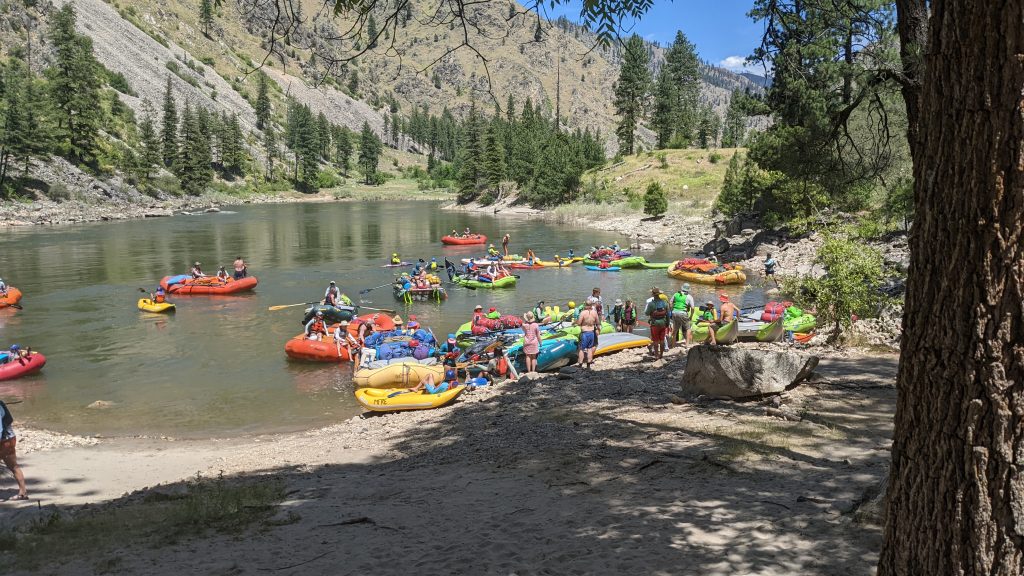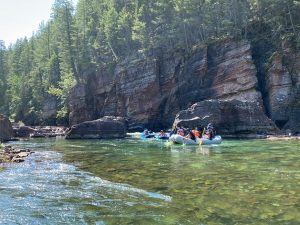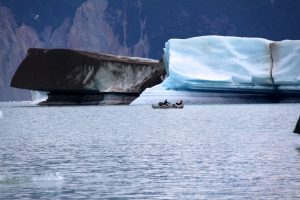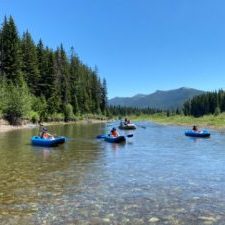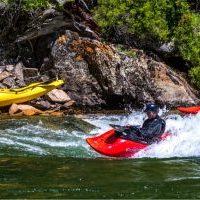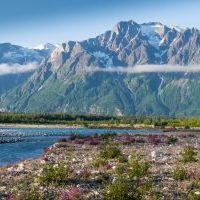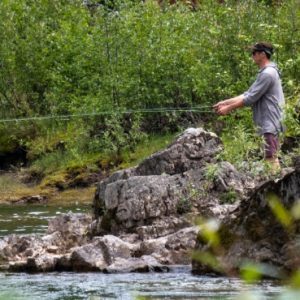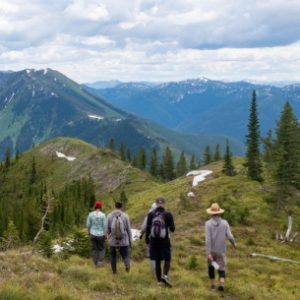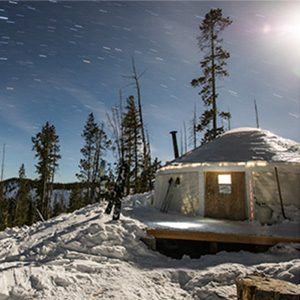The Fire Talk Series, Episode 2: Caretaking in the Frank Church
April 11, 2023
Written by Carly Knudson
About the Fire Talk Series:
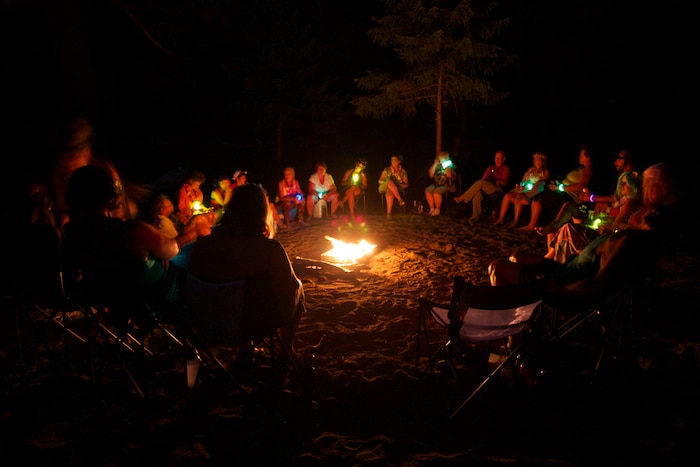
I have met and shared so many wonderful exchanges with so many different types of people and experts in their own domains, which always reminds me to embrace individuality and the uniqueness of each of our lives. Each episode will be inspired by some aspect of guiding, rivers, experiencing wild places, or adventure, and we hope to bring a little bit of Idaho and wonder back to you, wherever you are at in your lives. (Featured photo by Nyima Ming)
Episode 2: Caretaking in the Frank Church
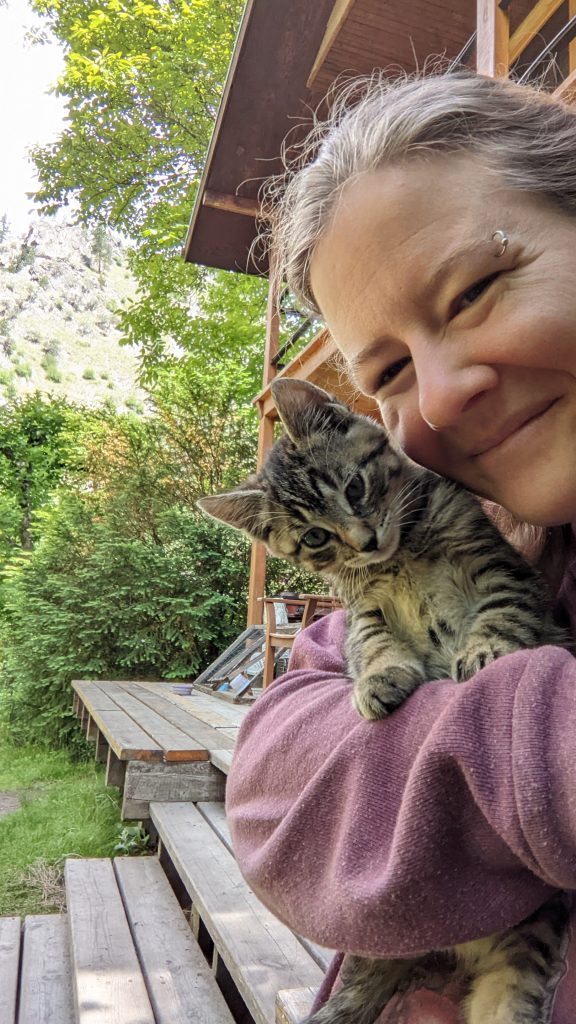
Alice was born in Boise and fell in love with the Salmon River as a child. She attended Colorado College and received a bachelor’s degree in Geology, then moved to the backcountry in 2016. She has worked at a number of ranches along the Main Salmon corridor and now splits her time between Buckskin Bill’s and Mackay Bar. She enjoys running around in the wilderness, learning new backcountry skills, and traveling the world at large.
If you are fortunate enough to have been able to experience a multiday river trip, you understand the joyous feelings of being immersed in the remote and rugged. There is something truly special about taking a small break living without the demands of our office jobs, freeing ourselves of technology, reconnecting with wild landscapes, practicing “leave no trace” ethics, only bringing and taking the things we need, adventuring and exploring around, and pooping outside in portable metal boxes. Many of us cherish these “breaks” from our everyday lives as moments to reset and rejuvenate us, to refresh our perspectives, reconnect, and to express gratitude for things we often take for granted. After 6-12 days, many of us also look forward to returning to the comforts and convenience of our day-to-day lives that we have grown accustomed to.
But what about those of us who choose to live full-time off the grid?
Today, we are exploring the job and lifestyle of caretaking in the wilderness by chatting with Alice Forbes, who has lived and worked in the Frank Church Wilderness for 7 years. We are asking her about the career of caretaking, the wonders and challenges of living off-the-grid, and why protecting and educating people about important places is essential to the integrity of our industry.
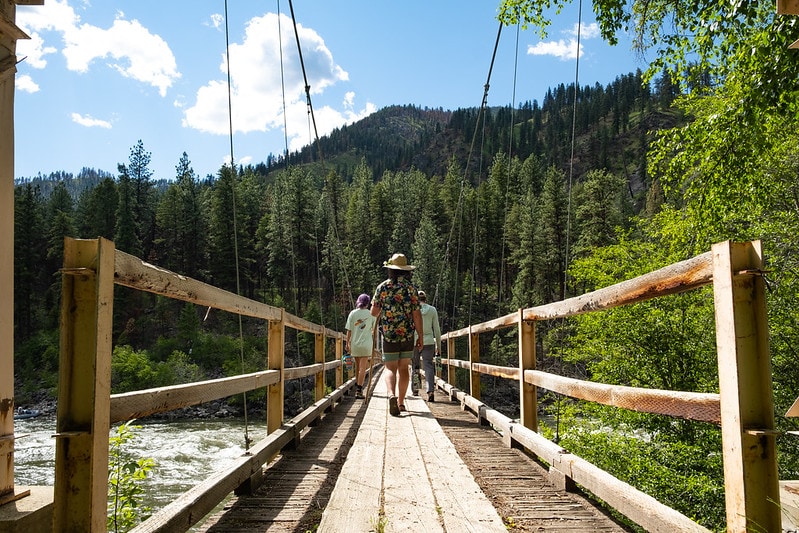
The Main and Middle Fork Salmon rivers cut through the heart of the Frank Church River of No Return Wilderness, more than 2.4 million acres of land and water protected from human impact. The designation by the Wilderness Act was intended to preserve wild spaces in their “natural condition,” minimizing further development to secure the benefits of wilderness for present and future generations to come.
However, as many of us know, prior to the 1980 designation of the Frank Church Wilderness, there were many already established human inhabitants of the cooridor who relied on the landscape for their culture and livlihoods. The first Niimiipuu (Nez Perce) and Tukudeka/ Agaideka Newe (Shoshone-Bannock) people have called these lands their home for thousands of years prior to European settlement. Later in the 1900’s, European industry such as mining, fur trade, and supply transport brought colonizers into the Salmon corridor, some choosing to brave the rugged landscape as a place of permanent residence.
There are notable structures whose history are still able to be witnessed to this day, as governement-recognized land inhabitants with homesteads established before the passing of the Wilderness Act had their properties “grandfathered in.” Others settled based on mining claims, and others… well they just kind of “settled.”
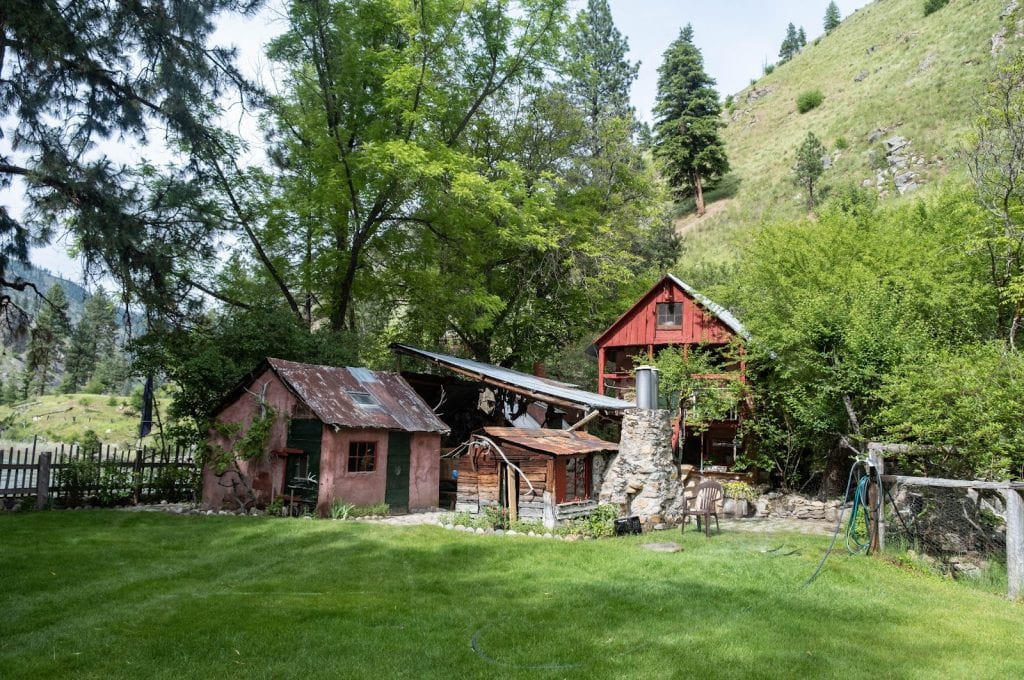
Many of the most beloved characters of the corridor are of the hermit/ anti-government/ hide out-from-society type. A notable Main Salmon icon is Sylvan Hart, aka “Buckskin Bill,” whose hand-build pink stucco buildings, quirky demeanor, artisan-crafted tools, looming watchtower and fading photos of Buckskin with beautiful women are conserved in a museum on his property on 5 Mile Bar. Buckskin often feels more of a character than a real person, with his scraggly, cartoonish voice, catchy sayings, and adornment of handmade viking-style helmets. Aside from the romantacism of characters like Buckskin, I think many of us often revere the folks who reject norms, and choose lifestyle and simplicity over comfort and convenience.
What we often don’t talk about in terms of history of these places, are the people who live and work in them today. For structures and properties like 5 Mile Bar to remain intact and functioning, it is required for people to live, care, and watch after the property year-round. Caretakers provide an incredibly rich resource of knowledge and insight of the importance and history of the space, while making it possible for others to experience and enjoy the places and histories to their fullest extent.
Below, you can read the transcripts from a conversation that Alice and I had this spring, in which she gives me a glimpse into the life “behind the scenes” at 5 Mile Ranch and Macky Bar, the two places she splits her time working at in the River of No Return backcountry. If you come out on the river with us this summer on the Main Salmon, be sure to tell Alice hi, and THANK YOU for all that they do!
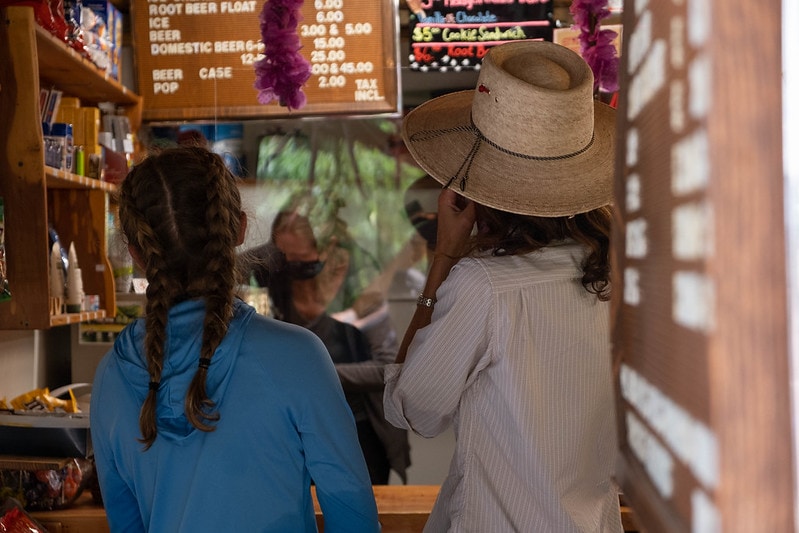
Can you tell me a little bit about yourself, and how you got into working at these backcountry spaces/ the jobs you have now?
I was pretty lucky to grow up in Boise, ID with a family who hung out and spent a lot of time with Barbara and Heinz (the current owners) in the 80’s at 5 Mile Bar. My mom met a friend of Barbara’s working at Macky Bar on the Main Salmon, which is how they initially got connected and became friends in a funny round about way. When I was a kid in the 90’s, I got to visit and play around that area and learned to love it, and always wanted to be the “store girl” who sold ice cream and helped around the property. When I was finishing up my degree in geology, the timing worked out perfectly with the job opening up. I realized going out there in the summer that I wanted to find a way that I didn’t have to leave at the end of the season. You don’t really get the whole picture of the space and life in one season. I wanted to experience the entirety of it- just being there in a time that it really isn’t that accessible and there aren’t really people coming in and out that often. From there I found my gig working at Shep Ranch and Macky Bar in the fall/ winter for hunting season. I just didn’t really know where to go with my degree, and it seemed like I would rather spend my time in a job in a place and lifestyle I loved.
What is the story of “ownership” exchange with places like Buckskin Bills in wilderness spaces?
It kind of depends on the property and the timeframe we’re talking about. Some were actually technically owned with the Homestead Act, and understanding of being “grandfathered in,” and a lot were also mining claims, such as stories like 5 Mile Bar and Reho Wolf’s place. With 5 Mile particularly, Buckskin never really actually owned the property, it was a piece of the Painter Bar mining stake, and his newphew Rodney was one who actually bought a claim. He did help subsidize it into lots, and lived here with Mark Haynie as a caretaker. At the time, the now part-owners and caretakers Barbara and Heinz lived across the river in a teepee in the 80’s. After Buckskin Bill died in 1980, Mark invited them over to live on the property and help care take 1984. They then started the store in 1990, though many people assume it’s been there since the time of Buckskin! They eventually became part owners of the property, sharing with others who own vacation cabins on the property behind the main area visitors can see.
What are the logistics with living off-the-grid/ in the wilderness? How do you get in/ out, how often, how do you shop for groceries, get mail, communicate, get power, etc.
Well you try to really be thoughtful about what you need, when you need it, and why. I really only go to town for a couple of weeks during the winter for holidays, and one or two weekends during the busy season. This year I did get to travel to Greece, though in the winter! The main way to get in and out is with a Jet boat when the water levels are okay and the river isn’t frozen over. That’s typically between February and November in a normal year. [Editors note: If you haven’t seen them, these jetboats are technical whitewater machines, and require high levels of skill to navigate. Heinz had a jetboat business for a very long time transporting people and goods up and down the Main Salmon.] When the jet boats can’t run during the winter, you’ll get people/ goods out with the mail plane. The mail plane flies in once a week to Cascase, which is how we get groceries, mail, and ice cream for the summer! The pilots used to also be our personal shoppers, but now we use an online grocery ordering system.
For our communication, we use Starlink now. It’s honestly helped a lot with reliable communcation, and I think I get better service here than I do in Riggins. We used to use backcountry radios and sat phones, and will still use the radios at times if we need to.
The power along the Main Salmon used by most residences out here is a combination of hydroelectric and solar. Our hydro power comes from 5 Mile Creek, which are what the turbines and hosing that you can see are. We use solar primarily in the winter when the creek isn’t running as high. In case of emergengy we have a backup diesel engine.
What do your friends and family think about your lifestyle?
They’re into it! My parents always understood. They were the ones who initially brought me out here all the time as a kid, and they lived in a van together for a while. My friends took a little more time to get used to the idea and why exactly I was doing what I was doing, but once I got them out here to visit, they totally got it. You kind of have to experience the place to really understand. But now they all get to visit, which is awesome.
Why do you think it’s important for caretakers to continue to look after historically significant places like Buckskin Bills?
Well, you really HAVE to have caretakers and people actively living and working on these spaces year-round in order to maintain and preserve them. Places don’t really last out here unattended. Like Painter Bar, [the residence across the river] that used to have people living there only 30 years ago, but you would never know. It looks totally dilapidated and abandoned. Aside from just preserving the structures, though, I think we’re really helping to preserve the stories. Whether people like it or not, people have been living and inhabitanting these wilderness spaces for thousands of years. From the Native Americans to Buckskin, there’s a really important piece of history that needs to be recognized in order to understand the whole story of the landscape. Not only that, but I think it really helps people to just understand a different way of life and living, and how that’s possible and works, which I think is really essential. Just to simplify.
What is your favorite part of your job/ living and working off the grid? What are the most challenging parts?
I really like the seasonality of all of it. There’s always something new going on every week or month, and looking forward to the transitions into new seasons, places and times of the year. I also really love the strong community that we have out here. People ask if I get lonely, and I say “No, because I’m not alone!” And also obviously it’s beautiful. It’s a pretty awesome office.
I think some of the more challenging parts are the fact that there are only so many career options out here. When you’re looking to progress or develop, there’s only so many places to go and things you can really do when you’re trying to figure out if it’s sustainable or not.
*HOLD ON! CAN I CALL YOU BACK? HEINZ JUST SHOWED UP IN THE JET BOAT WITH 100 CASES OF BEER!*
Do you have any really memorable guest moments while working in these backcountry spaces?
Last summer there was a woman who came up to the museum, and she was probably in her 80’s or so, and she pointed at one of the infamous photos of Buckskin with his arms around beautiful women, one wearing a skimpy, red polka dotted bikini. She exclaimed, “That’s me!” It turns out she was one of Buckskins friends who would fly in frequently to visit Buckskin. We sat around and talked for hours, and she told us how she would bring in a bar of soap for Buckskin (who probably never used it,) and would sometimes come in with her daughter. She had a photo of her daughter playing “Rapunzel” with Buckskin in the watchtower that she showed us. It was cool talking to one of Buckskin’s actual friends, because I think a lot of the photos of people with him are generally strangers. It was pretty awesome and there were some great stories told back and forth that day,
Do you have any really fun Buckskin Bill facts or crazy experiences that have happened while out there to share?
I’ve been pretty lucky myself, and really haven’t had too much excitement while I’ve been on the property. But a lot can definitely go wrong. Some really memorable moments that I think about are the possibilities of natural disasters at any moment. There’s really only so much you can do when something like that happens, and life just kind of has to keep moving forward.
Like in the early 2000’s, the workshop at Five Mile Bar caught fire. Barbara and Heinz spent all night trying to fight the fire, but ulitimately it ended up burning down. Heinz had gotten really bad burns all over his arms, and jetted out to Riggins with the help of a friend. After he had been treated, despite normal protocols, he just had to go straight back to work, because he had jet boat clients and trips he had to get back to.
Another year in 2008 and a big fire season, 5 Mile Creek blew out. You can try to build diversions and sand bags and do everything you can to try to protect the property, but ultimately, Mother Nature rules. You just kind of have to sit back and wait and hope for the best. Luckily, it only ended up damaging the backyard, but still feels like a very close call!
Do you have any really fun Buckskin Bill facts?
He made his own teeth out of elk ivories!
What do you think Buckskin Bill would say about/ to all the people visiting his home and eating ice cream in his yard?
He would honestly probably like the attention. Buckskin is a pretty funny juxtaposition of being a hermit while also being a showman. He seems like the world’s friendliest hermit (Unless you are trying to take his land away.) He would proabably just smirk and take some more bikini pictures.
Is there anything else you think is important for people to know about your job, living off the grid, Buckskin, etc.?
It’s not for everyone- but it’s awesome. There’s a big difference of doing this type of work for a couple of weeks versus year round. But I always have people coming in telling me their stories of when they did similar work somewhere deep in the backcountry, and it’s always a really major life event that they often say was one of their favorite phases of their life. I think it’s a really important thing to experience.
